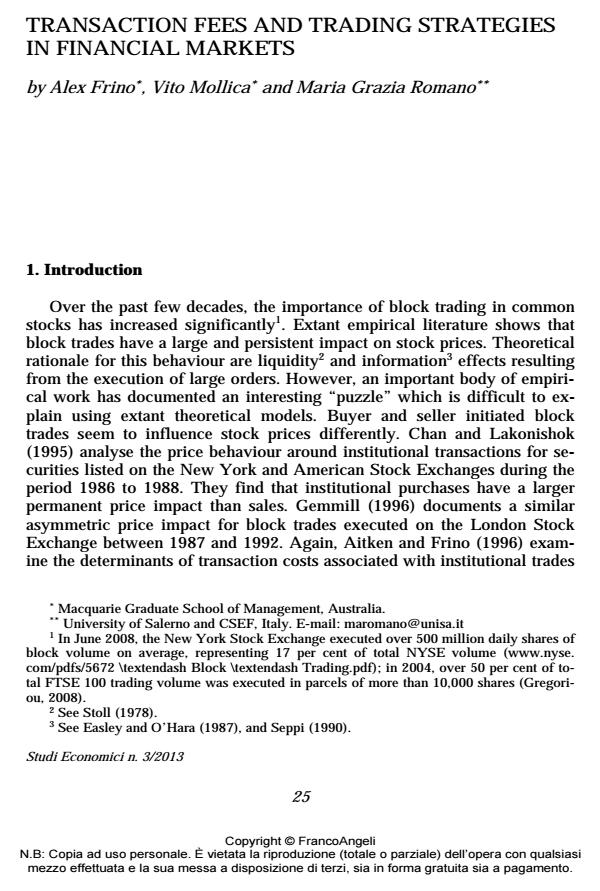Transaction fees and trading strategies in financial markets
Titolo Rivista STUDI ECONOMICI
Autori/Curatori Alex Frino, Vito Mollica, Maria Grazia Romano
Anno di pubblicazione 2015 Fascicolo 2013/111
Lingua Italiano Numero pagine 25 P. 25-49 Dimensione file 184 KB
DOI 10.3280/STE2013-111002
Il DOI è il codice a barre della proprietà intellettuale: per saperne di più
clicca qui
Qui sotto puoi vedere in anteprima la prima pagina di questo articolo.
Se questo articolo ti interessa, lo puoi acquistare (e scaricare in formato pdf) seguendo le facili indicazioni per acquistare il download credit. Acquista Download Credits per scaricare questo Articolo in formato PDF

FrancoAngeli è membro della Publishers International Linking Association, Inc (PILA)associazione indipendente e non profit per facilitare (attraverso i servizi tecnologici implementati da CrossRef.org) l’accesso degli studiosi ai contenuti digitali nelle pubblicazioni professionali e scientifiche
The article examines the impact of transaction costs on the trading strategy of informed institutional investors in a sequential trading market where traders can choose to transact a large or a small amount of stock. The analysis shows how the trading strategy of informed investors and the price impact of their trades depends on market conditions. The main prediction of the model is that institutional buyers are, on average, more aggressive than institutional sellers in bearish markets and less aggressive in bullish markets. Hence, the price impact is higher for purchases when market conditions are bearish, while it is higher for sales when market conditions are bullish. However, this asymmetry vanishes during strongly bearish or bullish phases, when information-based orders stop because the informational advantage of institutional investors becomes too small with respect to the transaction costs.
Parole chiave:Block trade, market impact, asymmetry
Jel codes:G14, G15
- Aitken M.J., Frino A. (1996), “Execution costs associated with institutional trades on the Australian Stock Exchange”, Pacific-Basin Finance Journal, 4: 45-58.
- Banerjee A. (1992), “A Simple Model of Herd Behavior”, Quarterly Journal of Economics, 107: 797-817.
- Bessembinder H. (2003), “Issues Assessing in Trade Execution Costs”, The Journal of Financial Markets, 6: 233-257.
- Bikhchandani S., Hirshleifer D., Welch I. (1992), “A Theory of Fads, Fashion, Custom and Cultural Change as Informational Cascades”, Journal of Political Economy, 100: 992-1026.
- Chan L.K.C., Lakonishok J. (1993), “Institutional trades and intraday stock price behaviour”, Journal of Financial Economics, 33: 173-199.
- Chan L.K.C., Lakonishok J. (1995), “The behaviour of stock prices around institutional trades”, Journal of Finance, 50: 1147-1174.
- Chiyachantana C.N., Jain P.K., Jiang C., Wood R.A. (2004), “International evidence on institutional trading behaviour and price impact”, Journal of Finance, 59: 869-898.
- Easley D.N., O’Hara M. (1987), “Price, trade size, and information in securities markets”, Journal of Financial Economics, 19: 69-90.
- Ellis K., Michaely R., O Hara M. (2000), “The accuracy of trade classification rules: Evidence from NASDAQ”, Journal of Financial and Quantitative Analysis, 35: 529-552.
- Gemmill G. (1996), “Transparency and liquidity: A study of block trades in the London Stock Exchange under different publication rules”, Journal of Finance, 51: 1765-1790.
- Glosten L., Milgrom P. (1985), “Bid, Ask, and Transaction Prices in a Specialist Market with Heterogeneously Informed Traders”, Journal of Financial Economics, 14: 71-100.
- Gregoriou A. (2008), “The asymmetry of the price impact of block trades and the bid-ask spread: Evidence from the London Stock Exchange”, Journal of Economic Studies, 35: 191-199.
- Hirshleifer D., Teoh S.H. (2003), “Herd Behavior and Cascading in Capital Markets: a Review
- and Synthesis”, European Financial Management, 9: 25-66. Holthausen R., Leftwich R., Myers D. (1987), “The effect of large block transactions on security prices: A cross-sectional analysis”, Journal of Financial Economics, 19: 237-268.
- Holthausen R., Leftwich R., Myers D. (1990), “Large-block transactions, the speed of response, and temporary and permanent stock-price effects”, Journal of Financial Economics, 26: 71-95.
- Keim D.B., Madhavan A. (1995), “Anatomy of the trading process: Empirical evidence on the behaviour of institutional traders”, Journal of Financial Economics, 37: 371-398.
- Keim D.B., Madhavan A. (1996), “The upstairs market for large-block transactions: Analysis and measurement of price effects”, Review of Financial Studies, 9: 1-36.
- Kraus A., Stoll H. (1972), “Price impacts of block trading on the New York Stock Exchange”, Journal of Finance, 27: 569-588.
- Lee C.M.C., Ready M.J. (1991), “Inferring trade direction from intraday data”, Journal of Finance, 46: 733-746.
- Saar G. (2001), “Price impact asymmetry of block trades: An institutional trading explanation”, Review of Financial Studies, 14: 1153-1182.
- Seppi D.J. (1990), “Equilibrium Block Trading and Asymmetric Information”, The Journal of Finance, 45: 73-94.
- Stoll H. (1978), “The Supply od Dealer Services in the Securities Markets”, The Journal of Finance, 33: 1133-1151.
Alex Frino, Vito Mollica, Maria Grazia Romano, Transaction fees and trading strategies in financial markets in "STUDI ECONOMICI " 111/2013, pp 25-49, DOI: 10.3280/STE2013-111002